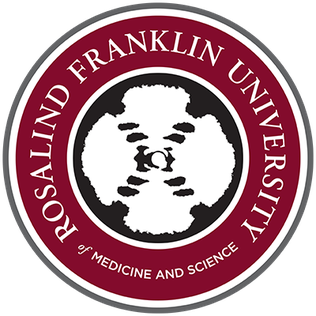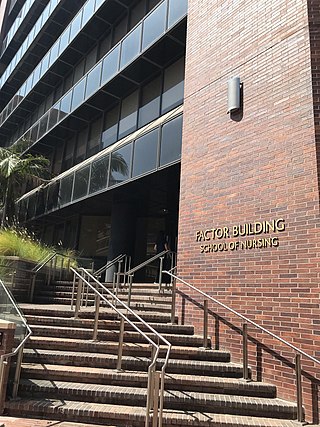
The Medical University of South Carolina (MUSC) is a public medical school in Charleston, South Carolina. It opened in 1824 as a small private college aimed at training physicians and has since established hospitals and medical facilities across the state. It is one of the oldest continually operating schools of medicine in the United States and the oldest in the Deep South.
The School of Nursing is the graduate school of nursing at Columbia University in the Washington Heights neighborhood of Manhattan, New York City. Founded in 1892, it stands as one of the oldest nursing schools in the United States.

The University of Tennessee Health Science Center (UTHSC) is a public medical school in Memphis, Tennessee. It includes the Colleges of Health Professions, Dentistry, Graduate Health Sciences, Medicine, Nursing, and Pharmacy. Since 1911, the University of Tennessee Health Science Center has educated nearly 57,000 health care professionals. As of 2010, U.S. News & World Report ranked the College of Pharmacy 17th among American pharmacy schools.

Rosalind Franklin University of Medicine and Science (RFU) is a private graduate school in North Chicago, Illinois. It has more than 2,000 students in six schools: Chicago Medical School, College of Health Professions, College of Nursing, College of Pharmacy, Dr. William M. Scholl College of Podiatric Medicine, and School of Graduate and Postdoctoral Studies. The university is named for famous DNA crystallographer Rosalind Franklin. Photo 51, an X-ray diffraction pattern of the B form of DNA, captured by Franklin in 1952, was pivotal in 20th-century history of biology. The image is depicted in the university's seal and logo.

Uniformed Services University of the Health Sciences (USU) is a health science university and professional school of the U.S. federal government. The primary mission of the school is to prepare graduates for service to the U.S. at home and abroad as uniformed health professionals, scientists and leaders; by conducting cutting-edge, military-relevant research; by leading the Military Health System in key functional and intellectual areas; and by providing operational support to units around the world.
The University of Texas Health Science Center at Houston (UTHealth) is a public academic health science center in Houston, Texas, United States. It was created in 1972 by The University of Texas System Board of Regents. It is located in the Texas Medical Center, the largest medical center in the world. It is composed of six schools: McGovern Medical School, The University of Texas MD Anderson Cancer Center UTHealth Graduate School of Biomedical Sciences, UTHealth School of Dentistry, Cizik School of Nursing, UTHealth School of Biomedical Informatics and UTHealth School of Public Health.

Rush University Medical Center (Rush) is an academic medical center in the Illinois Medical District neighborhood of Chicago, Illinois. It is the flagship hospital for the Rush University System for Health, which includes Rush Oak Park Hospital and Rush Copley Medical Center, and serves as the primary teaching hospital in affiliation with Rush University.

The Texas Tech University Health Sciences Center (TTUHSC) is a public medical school based in Lubbock, Texas, with additional campuses in Abilene, Amarillo, Dallas, and the Permian Basin. TTUHSC serves more than 100 counties in the western portion of Texas. The university is a separate institution from Texas Tech University; both universities are among five universities that are part of the Texas Tech University System. Texas Tech University Health Sciences Center El Paso, founded in 1969 as a branch campus of TTUHSC, became a separate institution in 2013.
The University of Illinois College of Medicine offers a four-year program leading to the MD degree at four different sites in Illinois: Chicago, Peoria, Rockford, and formerly Urbana–Champaign. The Urbana–Champaign site stopped accepting new students after Fall 2016 to make room for the newly established Carle Illinois College of Medicine.

The Kaohsiung Medical University is a private medical school located in Sanmin District, Kaohsiung, Taiwan.
The University of Cincinnati Academic Health Center (AHC) is a collection of health colleges and institutions of the University of Cincinnati, Cincinnati, Ohio. It trains health care professionals and provides research and patient care. AHC has strong ties to UC Health, which includes the University of Cincinnati Medical Center and West Chester Hospital.

The State University of New York Upstate Medical University is a public medical school in Syracuse, New York. Founded in 1834, Upstate is the 15th oldest medical school in the United States and is the only medical school in Central New York. The university is part of the State University of New York (SUNY) system.

The UCLA School of Nursing is a nursing school affiliated with UCLA, and is located in the Westwood neighborhood of Los Angeles, California. The school is housed in the Doris and Louis Factor Health Sciences Building, known as the Factor Building, on the south end of UCLA's 400-plus-acre campus, adjacent to the Ronald Reagan UCLA Medical Center.

Samuel Merritt University (SMU) is a private university focused on health sciences with its main campus in Oakland, California, and other facilities in Sacramento, San Mateo and Fresno. It was an affiliate of the Sutter Health Network and Alta Bates Summit Medical Center until becoming a wholly independent institution in January, 2022, upon its disaffiliation from Sutter Health. It is the only provider of physical therapists, occupational therapists, and physician assistants and is the largest source of nurses in the greater East Bay. Formerly known as Samuel Merritt College, it was founded in 1909 as a hospital school of nursing. Today, it stands as a comprehensive health sciences university, encompassing three colleges: College of Nursing, College of Health Sciences, and College of Podiatric Medicine

The Philippine College of Health Sciences, Inc. is a school founded by Dr. George Cordero in 1993. It is located at 1813 Recto Avenue in Manila.

The University of South Florida College of Nursing is one of 14 colleges at the University of South Florida. The college has three campuses: Tampa, St. Petersburg, and Sarasota-Manatee.
Rocky Mountain University of Health Professions (RMUoHP) is a private, for-profit university focused on graduate healthcare education and located in Provo, Utah. It was established in 1998 and is accredited by the Northwest Commission of Colleges and Universities.
Saint Luke's College of Nursing and Health Sciences is a health sciences-focused college of Rockhurst University with its main campus in Kansas City, Missouri. It was formerly a private college associated with Saint Luke's Health System. It enrolls over 550 undergraduate students and 125 graduate students every year. The college offers associate degrees, bachelor's degrees, master's degrees, doctoral degrees, and certificates in nursing and health sciences.

The Mercer University Health Sciences Center opened on July 1, 2012. The Health Sciences Center has campuses in Macon, Atlanta, Savannah and Columbus in the U.S. state of Georgia.

AdventHealth University (AHU) is a Seventh-day Adventist institution specializing in healthcare education that is located in Orlando, Florida; Denver, Colorado; and online. It is associated with AdventHealth, which is operated by the Seventh-day Adventist Church. It is a part of the Seventh-day Adventist education system, the world's second largest Christian school system. The physical facilities are located next to AdventHealth Orlando and Centura Health in Denver. The university offers over 20 undergraduate and graduate degrees from associate to doctorate level, including online and post-baccalaureate certificates.














